Figure shows in cross section a wall consisting of four layers with thermal conductivities K1=0.06W/mK,K3=0.04W/mKandK4=0.10W/mK. The layer thickness are L1=1.5cm,L3=2.8cmandL4=3.5cm. The temperature of interfaces is as shown in figure. energy transfer through the wall is in steady state. the temperature of the interface between layer 3and4 is:
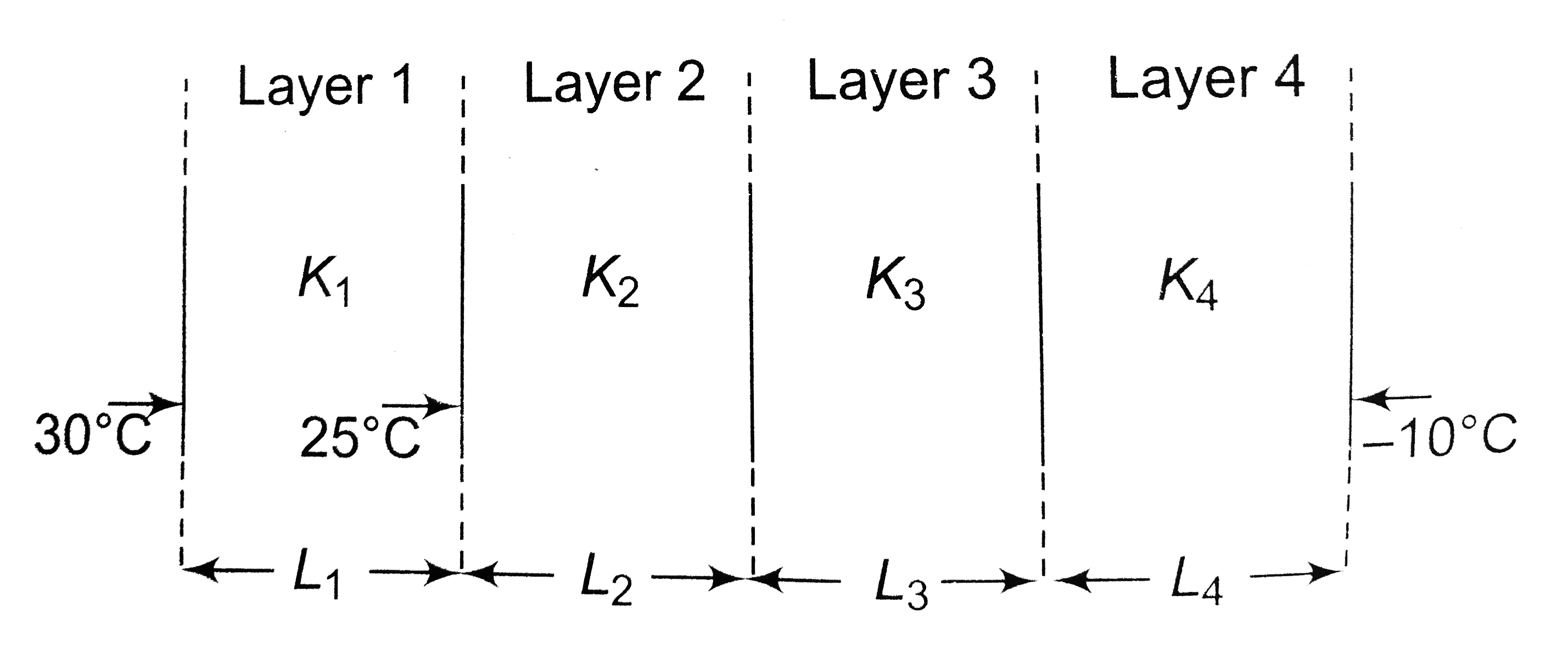
−1∘C
−3∘C
2∘C
0∘C
The correct Answer is:B
In steady state ΔQΔT∣∣∣layer1 = ΔQΔt∣∣∣layer4
⇒0.06×A×(30−25)1.5×10−2=0.10×A×ΔT3.5×10−2
⇒ΔT=7∘C
T3=(−10+7)∘C=−(3)∘C.
Topper's Solved these Questions
- BOOK - A2ZCHAPTER - THERMAL PROPERTIES OF MATTEREXERCISE - Transmission Of Heat : Radiation28videos
THERMAL PROPERTIES OF MATTER
- BOOK - A2ZCHAPTER - THERMAL PROPERTIES OF MATTEREXERCISE - Problems Baesd On Mixed Concepts18videos
THERMAL PROPERTIES OF MATTER
- BOOK - A2ZCHAPTER - THERMAL PROPERTIES OF MATTEREXERCISE - Calorimetry41videos
THERMAL PROPERTIES OF MATTER
- BOOK - A2ZCHAPTER - ROTATIONAL DYNAMICSEXERCISE - Chapter Test29videos
ROTATIONAL DYNAMICS
- BOOK - A2ZCHAPTER - UNIT, DIMENSION AND ERROR ANALYSISEXERCISE - Chapter Test28videos
UNIT, DIMENSION AND ERROR ANALYSIS
Similar Questions
Figure shows ( in cross section ) a wall consisting of four layers, with thermal conductivities k1=0.060W/m.K,k3=0.040W/m.K, and k4=0.12W/m.K(k2 is not known). The layer thickness are L1=1.2cm,L3=5.6cm, and L4=4.0cm (L2 is not known ) . The known temperatures are T1=30∘C,T12=25∘C, and T4=−10∘C . Energy transfer through the wall is steady. What is interface temperature T34 ?
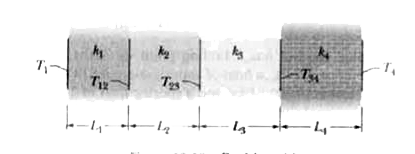 View Solution
View SolutionFigure shows the cross section of a wall made of three layers. The layer thicknesses are L1,L2=0.750L1, and L3=0.350L1. The thermal conductivities are k1,k2=0.900k1, and k3=0.800k1. The temperature at the left side and right side of the wall are TH=30.0∘C and TC=−15.0∘C, respectively. Thermal conduction is steady . (a) What is the temperature difference ΔT2 across layer 2 ( between the left and right sides of the layer ) ? If k2 were, instead, equal to 1.1k1, (b) would the reate at which energy is conducted through the wall be greater than, less than, or the same as proviously, and (c ) what would be the value of ΔT2 ?
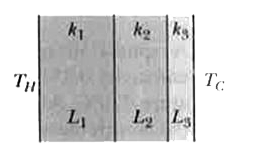 View Solution
View Solution
Knowledge Check
- Question 1 - Select One
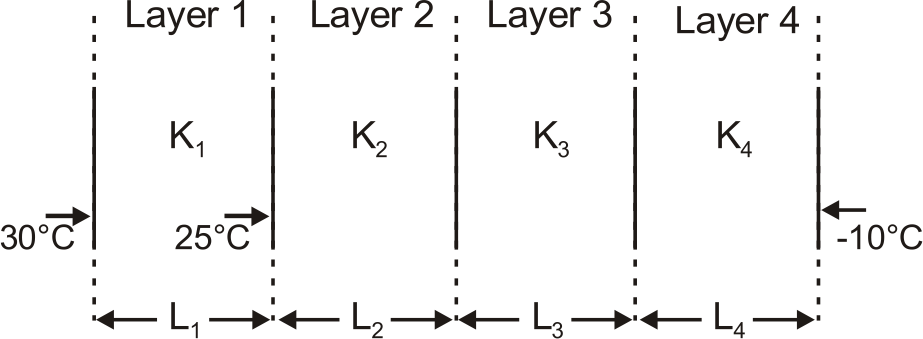
Figure shows in cros section a wall consisting of four layers with thermal conductivities K1=0.06W/mK
K3=0.04W/mK and K4=0.10W/mK. The layer thicknesses are L1=1.5cm,L3=2.8 cm and L4=3.5cm the temperature of interfaces is as shown in figure. energy transfer through the wall is in steady state.
Q. The temperature of the inteface between layers 2 and 3 isA11∘CB8∘CC7.2∘CD5.4∘C - Question 2 - Select One
Temperature shows in cross section a wall consisting of four layers with thermal conductivities K1=0.06W/mK,K3=0.04W/mK and K4=0.10W/mK the layer thickness are L1=1.5cm,L3=2.8cm and L4=3.5 cm. The temperature of interfaces is as shown in figure energy transfer through the wall is in steady state.
Q. Temperature of outer surface of sphere isA100∘B80∘C48∘D60∘ - Question 3 - Select One
Temperature shows in cross section a wall consisting of four layers with thermal conductivities K1=0.06W/mK,K3=0.04W/mK and K4=0.10W/mK the layer thickness are L1=1.5cm,L3=2.8cm and L4=3.5 cm. The temperature of interfaces is as shown in figure energy transfer through the wall is in steady state.
Q. Thickness of hollow sphere isA0.6 mmB0.52 mmC0.7 mmDnone of these
Three rods of the same dimension have thermal conductivity 3K, 2K and K as shown in the figure. The temperature of the junction in steady-state is
 View Solution
View SolutionThree rods of the same dimension have thermal conductivity 3K , 2K and K. They are arranged as shown in the figure below

Then , the temperature of the junction in steady - state isView SolutionTemperature shows in cross section a wall consisting of four layers with thermal conductivities K1=0.06W/mK,K3=0.04W/mK and K4=0.10W/mK the layer thickness are L1=1.5cm,L3=2.8cm and L4=3.5 cm. The temperature of interfaces is as shown in figure energy transfer through the wall is in steady state.
Q. Electric power of heater is:View SolutionTwo bars of thermal conductivities K and 3K and lengths 1cm and 2cm respectively have equal cross-sectional area, they are joined lengths wise as shown in the figure. If the temperature at the ends of this composite bar is 0∘C and K2/l respectively (see figure), then the temperature ϕ of the interface is
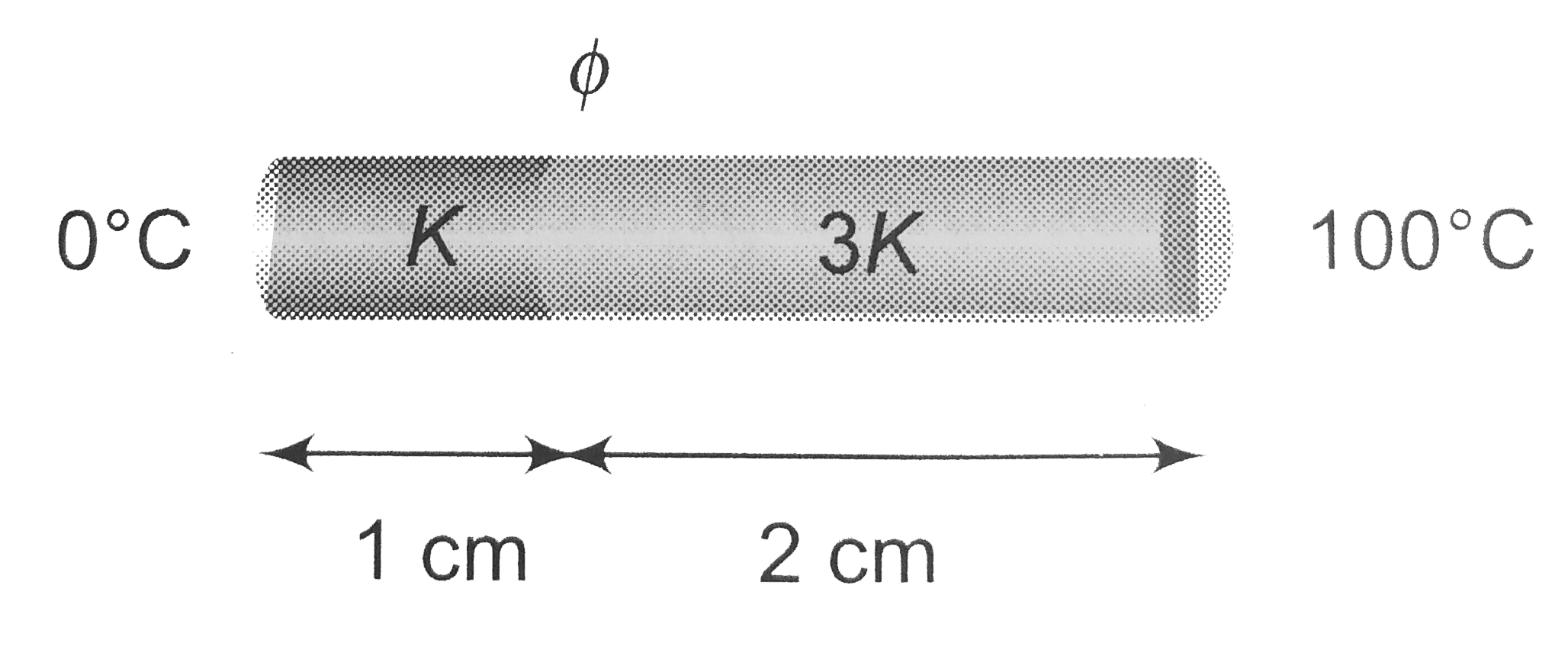 View Solution
View SolutionIf layer thickness L2 is 1.4cm, then its thermal conductivity K2 will have value (in W/mK)
View Solution

